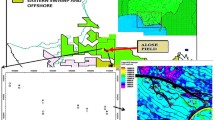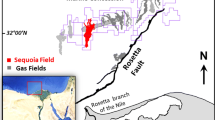Abstract
Accurate reservoir model requires complete information of subsurface properties, specifically porosity and permeability. Reservoir heterogeneity is the fundamental challenge for geoscientists to predict these properties which may affect the reservoir performance and their well productivity. Porosity is one of the key parameters for accumulation of hydrocarbon but its prediction is difficult due to significant variation over a reservoir volume. A spatial distribution of porosity can be investigated by integrating the 3-D seismic and well log attributes which may help in determining such reservoir variation. In addition, nonlinear multivariable regression techniques such as multivariable transform, Genetic algorithm, and Probabilistic Neural Network analysis have also been implemented to achieve high correlation coefficients between well log properties and seismic data. Results from nonlinear regression have better correlations than linear regression. In this study, a 3-D low frequency model (LFM) is proposed which can be estimated by kriging interpolation of resultant impedance values from well log data. Furthermore, “seismic inversion” is adopted for extracting correlated attributes to merge with the LFM so as to better construct a pseudo log volume. A polynomial neural network (PNN*1) is utilized to convert resultant acoustic impedance values into a distinct reservoir property such as porosity. PNN* is trained, tested and validated by using gammaray and resultant acoustic impedance values as input and effective porosity values as a target. The trained PNN* is then applied over the whole reservoir volume to generate a pseudo log volume. In the proposed low frequency model, an attempt has been made to achieve high correlation between the predicted and measured porosity logs. It will improve the reservoir characterization and lead to better estimation of hydrocarbon reserves. This low frequency model achieves better correlation between the predicted and true porosity log even with a minimum number of measured well logs.
Similar content being viewed by others
References
Alvan, H.V., 2011, Uncertainty of estimated petrophysical parameters of Ahvaz oil reservoir. Journal of Advanced Science and Engineering Research, 1, 165–176.
Anderson, J.K., 1996, Limitations of seismic inversion for porosity and pore fluid: lessons from chalk reservoir characterization and exploration. 66th Annual Meeting of Society of Exploration Geophysicists (Expanded Abstract), Denver, Nov. 10–15, p. 309–312.
Bakhshipour, Z., Huat, B.K., Ibrahim, S., Asadi, A., and Kura, N.U., 2013, Application of geophysical techniques for 3D Geohazard mapping to delineate cavities and potential sinkholes in the northern part of Kuala Lumpur, Malaysia. The Scientific World Journal, Article ID 629476. doi:10.1155/2013/629476 2013.
Balch, R.S., Weiss, W.W., and Wo, S., 1998, Correlating seismic attributes to reservoir properties using multivariate non-linear regression. Proceedings of the West Texas Geological Society Fall Symposium, Midland, Oct. 29–30, p. 199–203.
Banchs, R.E. and Michelena, J., 2002, From 3D seismic attributes to pseudo-well-log volumes using neural networks: practical considerations. The Leading Edge, 21, 996–1001.
Batzle, M. and Wang, Z., 1992, Seismic properties of pore fluids. Geophysics, 57, 1396–1408.
Chen, Q. and Sidney, S., 1997, Seismic attribute technology for reservoir forecasting and monitoring. The Leading Edge, 16, 445–50.
Choi, J.W., Byun, J.M., and Seol, S.J., 2011, Generation of pseudo porosity logs from seismic data using a polynomial neural network method. Journal of the Korean Earth Science Society, 32, 665–673.
Dadashpour, M., Ciaurri, D.E., Kleppe, J., and Landr, M., 2009, Porosity and permeability estimation by integration of production and time-lapse near and far offset seismic data. Journal of Geophysics and Engineering, 6, 1–32.
Dorrington, K.P. and Link, C.A., 2004, Genetic-algorithm/neuralnetwork approach to seismic attribute selection for well-log prediction. Geophysics, 69, 212–221.
Farlow, S.J., 1981, The GMDH algorithm of Ivakhnenko. American Statistician, 35, 210–215.
Fu, Q., Horvath, S., Potter, E., Roberts, F., Tinker, S.W., Ikonnikova, S., Fisher, W., and Yan, J., 2013, Log-based thickness and porosity mapping of the Barnett Shale Play, Fort Worth Basin, Texas: A proxy for reservoir quality assessment. Presented at the USA ssociation for Energy Economics Workshop on Unconventional Gas and Oil, Austin.
Gunning, J. and Glinsky, M.E., 2006, Wavelet extractor: A Bayesian well-tie and aavelet extraction program. Computers & Geosciences, 32, 681–95.
Hampson, D., Schuelke, J.S., and Quirein, J.A., 2001, Use of multiattribute transforms to predict log properties from seismic data. Geophysics, 66, 220–236.
Jia, T.Y., 2007, Characteristics of sedimentary facies and reservoir properties of some tertiary sandstone in Sabah and Sarawak, East Malaysia. M.Sc. Thesis, Universiti Sains Malaysia, Penang, 42 p. (in English with Malay abstract).
Kalkomey, C.T., 1997, Potential risks when using seismic attributes as predictors of reservoir properties. The Leading Edge, 16, 247–251.
Leiphart, D.J. and Hart, B.S., 2002, Case history: Comparison of linear regression and a probabilistic neural network to predict porosity from 3-D seismic attributes in Lower Brushy Canyon channeled sandstones, southeast New Mexico. Geophysics, 66, 1349–1358.
Leite, E.P., 2010, Seismic model-based inversion using Matlab. In: Leite, E.P. (ed.), Matlab-Modelling, Programming and Simulations, Vol. 1: Computer Science and Engineering. Sciyo, InTech, 19, p. 405–412.
Liu, Z.P. and Castagna, J.P., 1999, Avoiding overfitting caused by noise using a uniform training mode. International Joint Conference on Neural Networks (Expanded Abstract), Washington, D.C., July 10–16, 3, p. 1788–1793.
McLean, J.K., Dulac, J.C., and Gringarten, E., 2012, Integrated Petrophysical Uncertainty Evaluation Impacts Reservoir Models. HART ENERGY, Exploration & Production. http://www.pdgm.com/resourcelibrary/articles-and-papers/2012/integrated-petrophysical-uncertaintyevaluation-im/.
Moore, W.R., Ma, Y.Z., Urdea, J., and Bratton, T., 2011, Uncertainty analysis in well-log and petrophysical interpretations. American Association of Petroleum Geologists Memoirs, 96, 17–28.
Oh, S.K. and Pedrycz, W., 2001, The design of self-organizing polynomial neural networks. Information Sciences Association for Computing Machinery Digital Library, 141, 237–258.
Oh, S.K., Pedrycz, W., and Park, B.J., 2001, Polynomial neural networks architecture: Analysis and design. Computers & Electrical Engineering, 29, 703–725.
Priezzhev, I.I., 2010a, Prestack and poststack seismic inversion workflow in frequency domain. 4th International European Association of Geoscientists and Engineers Conference (Extended Abstract), Saint Petersburg, April 5–8, B24.
Riazi, N., Lines, L., and Russell, B., 2013, Integration of time-lapse seismic analysis with reservoir simulation. GeoConvention 2013: Integration, 61–66.
Sams, M.S., Neep, J.P., Worthington, M.H., and King, M.S., 1997, The measurement of velocity dispersion and frequency-dependent intrinsic attenuation in sedimentary rocks. Geophysics, 62, 1456–1464.
Singh, V.B., Negi, S.P.S., Subrahmanyam, D., Biswal, S., and Baid, V.K., 2004, Generation of pseudo-log volumes from 3D seismic multi-attributes using neural networks: A case study. 5th Conference and Exposition on Petroleum Geophysics, Hyderabad, Jan. 15–17, p. 541–549.
Specht, D.F., 1990, Probabilistic neural networks. Neural Networks, 3, 109–118.
Stephen, K.D., Soldo, J., Macbeth, C., and Christie, M.A., 2006, Multiple model seismic and production history matching: A case study. Society of Petroleum Engineers Journal, 11, 418–430.
Taner, M.T., Koehler, F., and Sheriff, R.E., 1979, Complex seismic trace analysis. Geophysics, 44, 1041–1063.
Taner, M.T., Schuelke, J.S., O’Doherty, R., and Baysal, E., 1994, Seismic Attributes Revisited. 64th International Annual Meeting of Society of Exploration Geophysicists (Expanded Abstracts), Los Angeles, Oct. 23–28, p. 1104–1106.
Todorov, T.I., 2000, Integration of 3C-3D seismic data and well logs for rock property estimation. M.Sc. Thesis, University of Calgary, Calgary, 94 p.
Tonn, R., 2002, Neural network seismic reservoir characterization in a heavy oil reservoir. The Leading Edge, 21, 309–312.
Uden, R.C., Smith, M., and Hubert, L., 2003, Neural network training for reservoir characterization of litho facies. 65th European Association of Geoscientists and Engineers Conference and Exhibition, Stavanger, June 2–5, p. 99.
Valenti, J.C., 2009, Porosity prediction from seismic data using multiattribute transformations, N Sand, Auger Field, Gulf Of Mexico. M.Sc. Thesis, The Pennsylvania State University, University Park, 84 p.
Widuri, I., 2012, Seismic multi-attributes analysis to predict lithology distribution and porosity. 74th European Association of Geoscientists and Engineers Conference and Exhibitions (Expanded Abstracts), Copenhagen, June 4–7, p. 1–4.
Xu, S. and White, R.E., 1995, A new velocity model for clay-sand mixtures. Geophysical Prospecting, 43, 91–118.
Author information
Authors and Affiliations
Corresponding author
Additional information
Note that PNN stands for Polynomial Neural Network (for mathematic) in this study. The abbreviation for Probabilistic Neural Network used in science and engineering is also PNN.
Rights and permissions
About this article
Cite this article
Kumar, A., Khir, M.H.M. & Yusoff, W.I.W. A model-based approach for integration analysis of well log and seismic data for reservoir characterization. Geosci J 20, 331–350 (2016). https://doi.org/10.1007/s12303-015-0045-y
Received:
Accepted:
Published:
Issue Date:
DOI: https://doi.org/10.1007/s12303-015-0045-y




